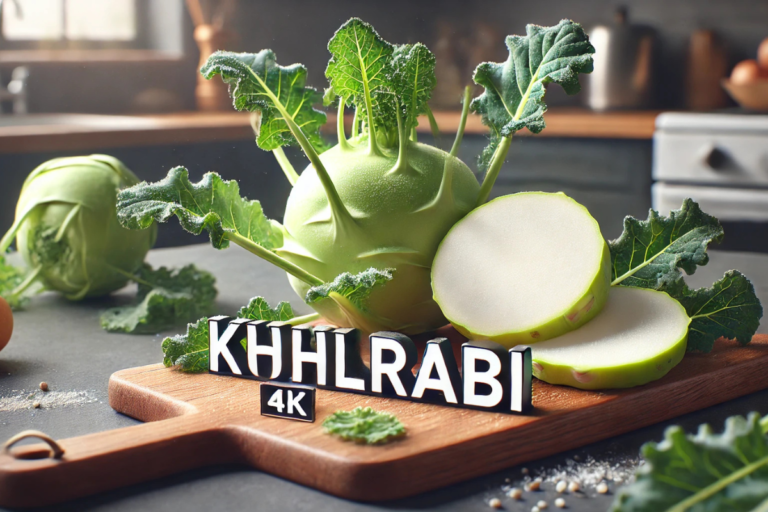What is Kohlrabi?
Kohlrabi is a vegetable that belongs to the same family as cabbage, broccoli, and cauliflower. It is often called a “cabbage turnip” because of its shape and taste. Kohlrabi is round, with a thick outer layer that can be green or purple, but its flesh inside is always white. The taste of kohlrabi is mild and sweet, similar to broccoli stems or a blend of cabbage and radish.
This vegetable first became popular in Europe. The name “kohlrabi” comes from the German words “kohl” (cabbage) and “rabi” (turnip). People have been growing and eating kohlrabi for hundreds of years, especially in countries like Germany, India, and Italy.
Kohlrabi grows above the ground and has long, leafy stems that sprout from the top. It can be eaten raw or cooked, making it a versatile choice for different dishes. The vegetable is rich in nutrients and has become more popular as a healthy food option around the world.
Nutritional Benefits of Kohlrabi
Kohlrabi is packed with essential nutrients that can benefit your health. It is a good source of Vitamin C, fiber, and potassium. Here’s why each of these nutrients is important:
- Vitamin C: Helps boost the immune system, fights off infections, and aids in collagen production, which keeps skin healthy.
- Fiber: Supports digestive health by promoting regular bowel movements and can help manage blood sugar levels. It keeps you feeling full longer, which can aid in weight control.
- Potassium: Regulates fluid balance in the body, supports muscle function, and helps maintain healthy blood pressure.
Kohlrabi also contains small amounts of Vitamin B6, magnesium, and folate, adding to its overall nutritional value. Compared to other cruciferous vegetables like broccoli, cabbage, and Brussels sprouts, kohlrabi holds its own. It offers a similar nutritional profile but is lower in calories, making it a good choice for those looking to eat healthily while managing weight.
In addition to its nutrients, kohlrabi has anti-inflammatory properties that can reduce the risk of chronic diseases. Its high fiber content can help improve digestion and reduce the risk of constipation.
Different Types of Kohlrabi
There are two main types of kohlrabi: green and purple. Both types have the same white flesh inside and a similar taste, but they differ in appearance and, to some extent, in how they are used.
- Green Kohlrabi: This type is the most common and has a pale green skin. It has a milder, sweeter flavor, making it ideal for raw salads, slaws, or snacks.
- Purple Kohlrabi: The skin of this variety is deep purple, but the inside remains white. It has a slightly stronger taste, making it more suitable for cooked dishes like stir-fries, soups, or roasted vegetables.
In terms of texture, both green and purple kohlrabi are crunchy and juicy when raw. Cooking kohlrabi softens it, making it tender. While the green variety is often favored for raw consumption, the purple one’s vibrant color makes it an attractive addition to cooked dishes.
How to Grow Kohlrabi in Your Garden
Growing kohlrabi at home is simple if you know what it needs. Here are some tips to help you grow healthy kohlrabi:
- Soil and Growing Conditions: Kohlrabi grows best in well-drained, fertile soil. It prefers a pH level between 6.0 and 7.5. Make sure the soil is rich in organic matter, like compost, to promote healthy growth. It needs plenty of sunlight, so choose a sunny spot in your garden.
- Planting Time: Kohlrabi is a cool-season vegetable. It grows well in spring and fall when temperatures are cooler. For spring planting, sow seeds indoors about 6 weeks before the last frost, then transplant them outside. For fall planting, sow seeds directly in the garden 10-12 weeks before the first expected frost.
- Maintaining Your Garden: Water kohlrabi regularly, keeping the soil moist but not soggy. Add mulch around the plants to retain moisture and control weeds. Fertilize with a balanced fertilizer every few weeks to provide necessary nutrients.
- Pests and Diseases: Watch for common pests like aphids, cabbage worms, and flea beetles. Use natural pest control methods like neem oil or insecticidal soap. Kohlrabi can also be affected by diseases like clubroot and powdery mildew. To prevent these, practice crop rotation and avoid planting kohlrabi in the same spot each year.
How to Harvest and Store Kohlrabi
Kohlrabi is easy to harvest and store if you follow the right steps. Here’s how you can do it:
- Knowing When to Harvest: Kohlrabi is ready to harvest when the bulb reaches about 2-3 inches in diameter, which usually takes about 45-60 days from planting. The bulb should be firm and smooth to touch. If it grows larger than 4 inches, it may become tough and woody, making it less tasty.
- Step-by-Step Guide to Harvesting:
- Choose a cool morning to harvest for the freshest results.
- Use a sharp knife or garden shears to cut the kohlrabi at the base, right above the soil level.
- Remove the leaves from the bulb by cutting them off, but don’t throw them away—kohlrabi leaves are edible and nutritious.
-
Best Ways to Store Kohlrabi:
-
- Refrigeration: Place kohlrabi bulbs in a perforated plastic bag and store them in the refrigerator. They can stay fresh for up to 2 weeks.
- Root Cellar: If you have a root cellar, you can store kohlrabi there for longer, as it thrives in cool, damp conditions.
-
How to Preserve Kohlrabi:
-
- Freezing: Peel and cut kohlrabi into cubes, blanch them in boiling water for 2 minutes, and then transfer to an ice bath. Once cooled, place the cubes in a freezer bag and store them for up to 6 months.
- Pickling: Slice the kohlrabi into thin rounds and place them in a jar with vinegar, salt, sugar, and spices. Let it sit in the refrigerator for a few days to create a tangy pickled kohlrabi.
How to Prepare and Cook Kohlrabi
Kohlrabi is versatile and can be enjoyed in many ways. Here’s how to get it ready for cooking:
-
Peeling, Cutting, and Preparing Kohlrabi:
- Start by trimming off the leaves and cutting off the bottom end.
- Use a sharp vegetable peeler or knife to remove the tough outer layer.
- Slice or dice the inner flesh into your desired shape, depending on the recipe.
-
Top Cooking Methods:
- Roasting: Toss kohlrabi cubes with olive oil, salt, and pepper, then roast in the oven at 400°F (200°C) for 20-25 minutes until golden and tender.
- Steaming: Cut kohlrabi into chunks and steam for 5-7 minutes until they are soft. Add a sprinkle of herbs or a drizzle of butter for extra flavor.
- Stir-Frying: Slice kohlrabi into thin strips and stir-fry with garlic, soy sauce, and your favorite vegetables for a quick meal.
-
Suggested Recipes:
- Kohlrabi Slaw: Grate raw kohlrabi and mix with shredded carrots, cabbage, and a tangy vinaigrette for a refreshing slaw.
- Kohlrabi Soup: Cook kohlrabi with onions, broth, and spices, then blend into a creamy soup.
- Kohlrabi Fries: Cut kohlrabi into sticks, toss with oil and spices, and bake until crispy for a healthy snack.
Kohlrabi in Global Cuisines
Kohlrabi is a popular vegetable in many cultures, each using it in unique and flavorful ways. Here’s how it’s prepared around the world:
- Germany: Kohlrabi has deep roots in German cuisine. It’s often boiled and served with a creamy white sauce or sautéed with butter. A classic German dish is Kohlrabischnitzel, where thick kohlrabi slices are breaded and fried, similar to a traditional schnitzel.
- India: In Indian cooking, kohlrabi is known as ‘knol-khol’ or ‘noolkol’ and is commonly used in curries, stir-fries, and pickles. It’s often cooked with spices like cumin, turmeric, and coriander. In the Kashmir region, kohlrabi is a staple ingredient in a dish called ‘monje haakh’, which is a spiced stew made with kohlrabi bulbs and leaves.
- Eastern Europe: In countries like Poland, Hungary, and the Czech Republic, kohlrabi is often added to soups and stews, enhancing the flavor with its mild sweetness. It’s also used in fresh salads, often shredded or julienned with other vegetables.
Health Precautions & Allergies Related to Kohlrabi
While kohlrabi is generally safe and healthy, there are a few precautions to keep in mind:
- Potential Allergies: Though rare, some people may experience an allergic reaction to kohlrabi, especially if they are sensitive to other cruciferous vegetables like broccoli or cabbage. Symptoms may include itching, swelling, or digestive discomfort.
- Dietary Restrictions:
- Thyroid Concerns: Kohlrabi, like other cruciferous vegetables, contains goitrogens, which can interfere with thyroid function. People with thyroid issues should consume it in moderation and preferably cooked, as cooking reduces goitrogen levels.
- Digestive Issues: The high fiber content of kohlrabi can cause gas or bloating in some people, especially if they are not used to consuming fiber-rich foods. Start with small portions and gradually increase your intake.
If you have any underlying health concerns, it’s best to consult a healthcare professional before adding large amounts of kohlrabi to your diet.
Why Include Kohlrabi in Your Diet?
Kohlrabi is a great addition to any balanced diet for several reasons:
- Nutrient-Rich: It’s loaded with vitamins, minerals, and antioxidants that promote good health. Its high Vitamin C content boosts immunity, while its potassium aids in maintaining healthy blood pressure.
- Low-Calorie, High-Fiber: Kohlrabi is low in calories but high in fiber, making it an ideal choice for those looking to lose weight or maintain a healthy weight. The fiber helps you feel full longer, reducing overall calorie intake.
- Versatile: Its mild, sweet flavor makes it suitable for a variety of dishes, whether you prefer it raw in salads or cooked in warm dishes. This makes it easy to include in different meals throughout the week.
Fun Facts About Kohlrabi
Kohlrabi is more than just a vegetable; it comes with some interesting trivia that might surprise you:
- “Space Cabbage”: Kohlrabi has been nicknamed “space cabbage” because it’s one of the vegetables considered for cultivation in space. Its ability to grow quickly and provide essential nutrients makes it a suitable candidate for future space missions.
- Ancient Cultivation: Kohlrabi has been cultivated since the Roman Empire, making it one of the oldest vegetables still grown today.
- Variety of Uses: In some cultures, kohlrabi leaves are just as popular as the bulb itself. The leaves are similar to kale or collard greens and can be used in salads, sautéed, or added to soups.
- German Favorite: In Germany, kohlrabi is so beloved that it’s sometimes called “the national vegetable.” It’s common in German gardens, homes, and recipes.
- Low Glycemic Index: Kohlrabi has a low glycemic index, making it an excellent choice for people managing blood sugar levels.
Where to Buy Kohlrabi?
Finding fresh kohlrabi is easy if you know where to look and what to consider:
- Local Grocery Stores: Kohlrabi is available in most supermarkets, especially in the produce section near other cruciferous vegetables like cabbage, broccoli, and cauliflower.
- Farmers’ Markets: For the freshest kohlrabi, visit your local farmers’ market. It’s more likely to be locally grown, making it fresher and tastier. You may even find different varieties, like the less common purple kohlrabi.
- Online Shopping: You can buy kohlrabi from online grocery delivery services. Some specialty sites even offer organic kohlrabi.
- What to Look For When Buying:
- Choose kohlrabi bulbs that are firm, with smooth skin and no cracks.
- Smaller bulbs (around 2-3 inches in diameter) are usually more tender and sweeter than larger ones, which can be woody.
- If the leaves are still attached, they should be fresh and green, not wilted or yellowed.
Conclusion
Kohlrabi is a unique, nutritious, and versatile vegetable that can easily become a staple in any diet. Its mild, sweet flavor, along with its high nutritional value, makes it a great addition to various dishes, whether raw or cooked. From boosting immunity to supporting weight management, kohlrabi offers many health benefits while being low in calories and high in fiber.
Whether you’re looking to add variety to your meals or grow a new vegetable in your garden, kohlrabi is a fantastic choice. With its rich history, global culinary appeal, and potential as a “space cabbage,” it’s a fascinating vegetable that offers much more than meets the eye. Try incorporating kohlrabi into your meals today to enjoy its flavors and health benefits!
Frequently Asked Questions (FAQs) About Kohlrabi
Is kohlrabi a fruit or vegetable?
Kohlrabi is a vegetable. It belongs to the cruciferous family, which includes broccoli, cabbage, and cauliflower.
Can you eat kohlrabi raw?
Yes, you can eat kohlrabi raw. It’s often used in salads, slaws, or as a crunchy snack. Just peel off the outer skin and slice the inner flesh as desired.
What does kohlrabi taste like?
Kohlrabi has a mild, slightly sweet flavor, similar to the stem of broccoli or a mix of cabbage and radish. It has a crisp texture, making it refreshing when eaten raw and tender when cooked.


